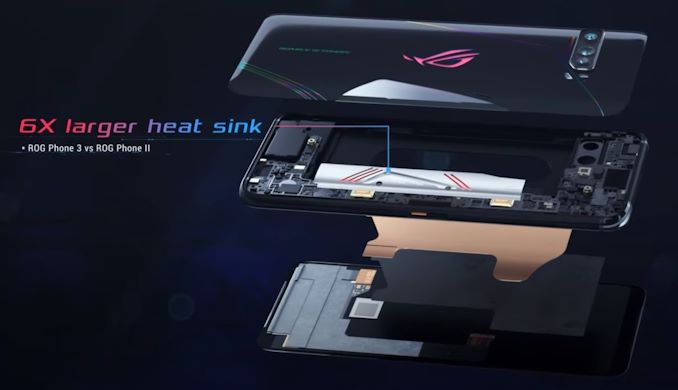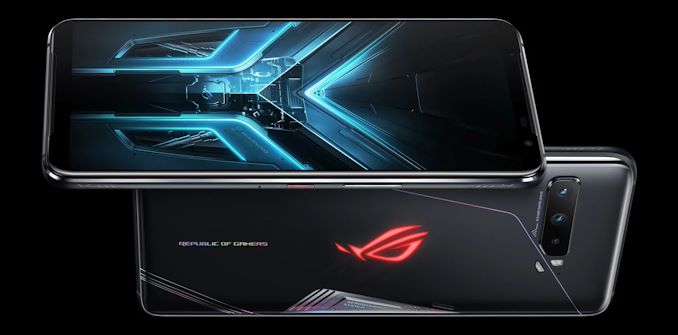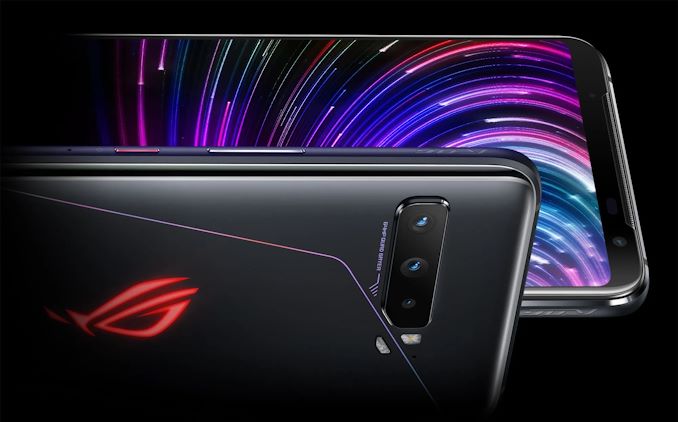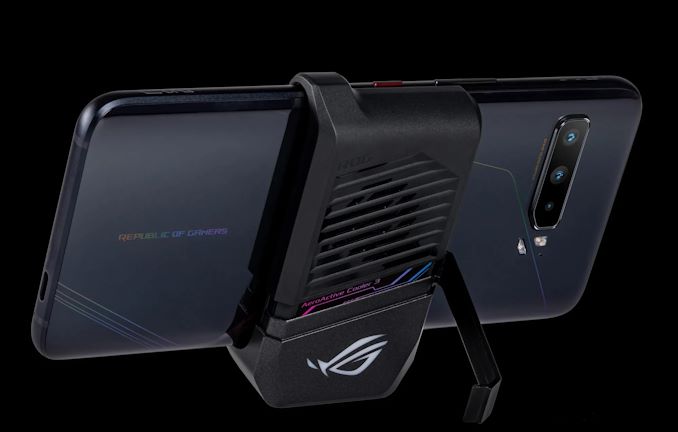ASUS Announces ROG Phone III - 144Hz S865+ Monster
by Andrei Frumusanu on July 22, 2020 1:00 PM EST- Posted in
- Smartphones
- Asus
- Mobile
- Snapdragon 865
- ROG Phone III

Today ASUS is announcing its newest flagship gaming-oriented phone, the ROG Phone III. A direct successor to the quite well received ROG Phone II from last year, the company is keeping the formula quite basic this year, keeping the general characteristics of the ROG Phone III similar to that to its predecessor whilst upgrading the core components such as the SoC, now featuring for the first time in a device the new Snapdragon 865+.
| ASUS ROG Phones | ||||||
| ROG Phone III | ROG Phone II | |||||
| SoC | Qualcomm Snapdragon 865+ 1x Cortex A77 @ 3.1GHz 3x Cortex A77 @ 2.42GHz 4x Cortex A55 @ 1.80GHz Adreno 650 @ +10% |
Qualcomm Snapdragon 855+ 1x Cortex-A76 @ 2.96GHz 3x Cortex-A76 @ 2.42GHz 4x Cortex-A55 @ 1.80GHz Adreno 640 @ 675MHz |
||||
| DRAM | 16 GB LPDDR5 | 12 GB LPDDR4X | ||||
| Storage | up to 512GB UFS 3.1 | 128 / 512GB UFS 3.0 | ||||
| Display | 6.59" AMOLED 2340 x 1080 (19.5:9) 144Hz 270Hz Touch |
6.59" AMOLED 2340 x 1080 (19.5:9) 120Hz 240Hz Touch |
||||
| Size | Height | 171.0 mm | 170.99 mm | |||
| Width | 78 mm | 77.6 mm | ||||
| Depth | 9.85 mm | 9.48 mm | ||||
| Weight | 240 grams | 240 grams | ||||
| Battery Capacity | 6000mAh 30W charging (PD) |
6000mAh |
||||
| Wireless Charging | - | |||||
| Rear Cameras | ||||||
| Main | 64MP IMX686 0.8µm pixels (1.6µm 4:1 16MP) |
48MP IMX586 0.8µm pixels (1.6µm 4:1 12MP) f/1.79 |
||||
| Telephoto | - | - | ||||
| Wide | 13MP 125° wide-angle |
13MP 125° wide-angle |
||||
| Extra | 5MP Macro | - | ||||
| Front Camera | 24MP | 24MP | ||||
| I/O | USB-C 3.1 (Side) + USB-C 2.0 (Bottom) |
USB-C 3.1 (Side) + USB-C 2.0 (Bottom) 3.5mm headphone jack |
||||
| Wireless (local) | 802.11ax WiFi-6 Bluetooth 5.1 LE + NFC |
802.11ac Wave 2 Wi-Fi Bluetooth 5.0 LE + NFC 802.11ad (Wireless display) |
||||
| Other Features | Dual Stereo Speakers Under-Display Fingerprint Sensor |
|||||
| Dual-SIM | Dual nanoSIM | |||||
| Launch Price | 8+256GB + S865 : 799€ 12+512GB + S865+: 999€ 16+512GB + S865+: 1099€ |
12+512GB: $899 / £829 / 899€ | ||||
The new SoC upgrades the CPU and GPU speeds by 10%, upping the frequencies on the Cortex-A77 cores to up to 3.1GHz for the first time ever in a smartphone. ASUS says that it’s also vastly upgraded the heat sink of the SoC inside the phone, with it now being 6x larger than that found on the ROG Phone II. Combined with a revamped vapour chamber design, the new phone is said to be virtually immune to thermal throttling and is able to keep is peak performance figures for prolonged periods even in demanding situations.
The phone also upgrades its RAM and storage options. You’re able to feature up to 16GB of LPDDR5 memory, whilst the 512GB NAND storage has been upgraded to an UFS 3.1 unit, improving transfer speeds by up to 15%.
On the display side, ASUS has kept the same screen size and resolution as on the ROG Phone II at 6.59” and 2340 x 1080, but this time around has upped the already high 120Hz refresh rate to up to 144Hz, with also an uptick in the input touch sampling rate to up to 270Hz. This being the biggest feature of the ROG Phone II, it’s arguably seen smaller upgrades this generation.
ASUS is seemingly also keeping a very similar footprint between generations as both phones still have 171 x 78mm length and widths, although the new phone is listed as being thicker at now up to 9.85mm. Weight hasn’t changed and still falls in at a hefty 240g, mostly taken up by the huge 6000mAh battery that also hasn’t seen changes this generation. Much like its predecessor, these are gigantic phones.
On the camera side of things, we’ve seen a big improvement on the main camera unit which has been switched from the previous generation IMX586 sensor to a newer IMX686. The upgrade here lies in its larger 1/1.72” sensor size, retaining 0.8µm pixels but being improved in resolution to up to 64MP with a quad-Bayer colour filter array, binning down to 16MP for regular mode shots. As of writing we don’t have information on the optics of the camera.
The ultra-wide-angle seems to have at surface remained the same at 13MP with a 125° field of view, but again we’re lacking specifics. An addition to the camera array is a 5MP macro camera which generally is more of a gimmick rather than something that augments the capture experience.
In terms of connectivity, of course the big upgrade is the move to 5G thanks to the new X55 modem. Wi-Fi 6 also the norm now and BT has been upgraded to version 5.1. We don’t see mention of ASUS’ “wireless display” functionality with 802.11ad so it might be the company has removed this feature this generation.
One other big feature that’s been removed is the 3.5mm headphone jack. Unfortunately, as in many other vendors this has gone the way of the Dodo, and is only otherwise available through ASUS’ AeroActive Cooler 3 add-on accessory which features a pass-through USB-C and 3.5mm port.
Availability in Europe later this month, the US in September
The ROG Phone III is said to first appear in Europe later this month in the form of a Strix variant with a regular Snapdragon 865 and 8+256GB of RAM for 799€, whilst the 12+512GB and 16+512GB variants will be offered later for 999€ and 1099€. In the US, the phone will only release in September with pricing there being released at a later date.
Related Reading:















64 Comments
View All Comments
ChefJeff789 - Wednesday, July 22, 2020 - link
I love the idea of super-high refresh rates and touch response. But jumping Jupiter, Batman, phone prices these days are completely out-of-control, even for these 'boutique' phones.trivik12 - Wednesday, July 22, 2020 - link
Considering 865+ is $230 or so and 144hz refresh screen must be super expensive, prices being so high is not crazy. On top of it 16GB LPDDR5 ram and UFS 3.1 storage. we are specing up these phones like crazy. Not sure you need that much in a small device.quiksilvr - Wednesday, July 22, 2020 - link
Once Android standardizes the whole "plug to a monitor and get a proper interface" locked down, we can start to see virtualization baked into phones. Imagine simply walking up to a WiDi monitor, bluetooth keyboard and mouse and your phone launches a Windows 10 VM wirelessly to those devices? You no longer need a laptop and can use x86 programs natively running on a VM on your phone. That is the future.Morawka - Thursday, July 23, 2020 - link
It's more likely that x86 goes the way of the DODO. With Apple swapping their entire Mac lineup to ARM, it won't be long before Microsoft and Adobe code their apps to work on mobile platforms.Speedfriend - Thursday, July 23, 2020 - link
I don't get the ARM will kill x86 argument. My iPad pro which benchmarks faster than my laptop, stutters playing Minecraft at times with nothing else running and chews through battery doing it. I suppose we will see when the first ARM Mac's launch. The development kits seem to have fairly ordinary performance unde emulation.LordSojar - Friday, July 24, 2020 - link
Well, if NVIDIA buys ARM, it's pretty much bye-bye Intel. AMD will probably also go ARM, as they have expressed interest. Maybe we'll finally have NV and AMD play nice, and the MBA-run disaster that is Intel will just become a name fading in memory. Hmmm... I do wonder about the possibilities.star-affinity - Sunday, August 2, 2020 - link
I don't think Minecraft on iPad is using Apple's Metal API for the graphics, but rather the deprecated OpenGL which doesn't perform very well plus we of course have the whole thing that games (i.e. software) can still perform bad despite the hardware being capable. :)Kraszmyl - Thursday, July 23, 2020 - link
Amusingly windows phones did this like five years ago and it works great.tuxRoller - Wednesday, July 22, 2020 - link
Where did you come by that bom figure for the 865+?close - Thursday, July 23, 2020 - link
It doesn't seem very realistic. Between models they charge 200E extra for the "+", 8GB of RAM and 256GB of storage extra. This means that the "+" itself can't be that much more expensive that the regular 865, and this is found in "relatively" cheap phones. Nothing that would suggest that just the SoC itself is 200E.